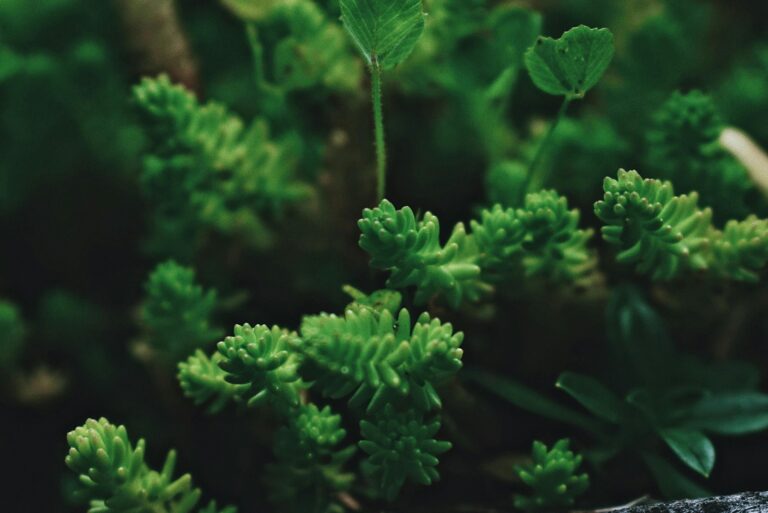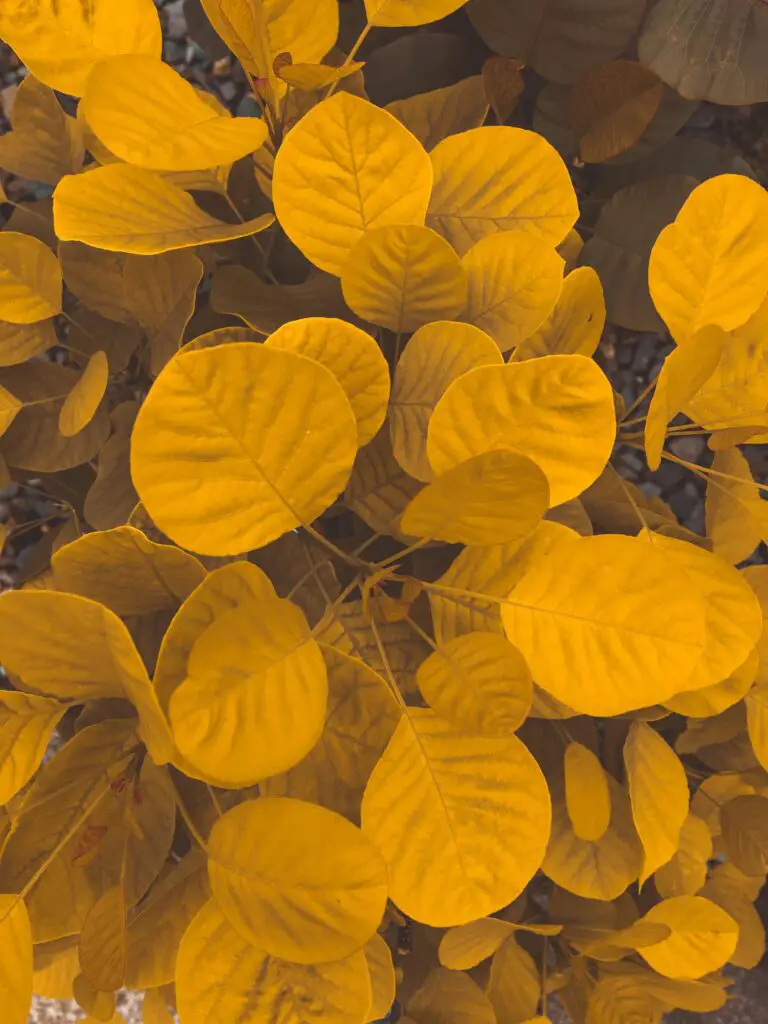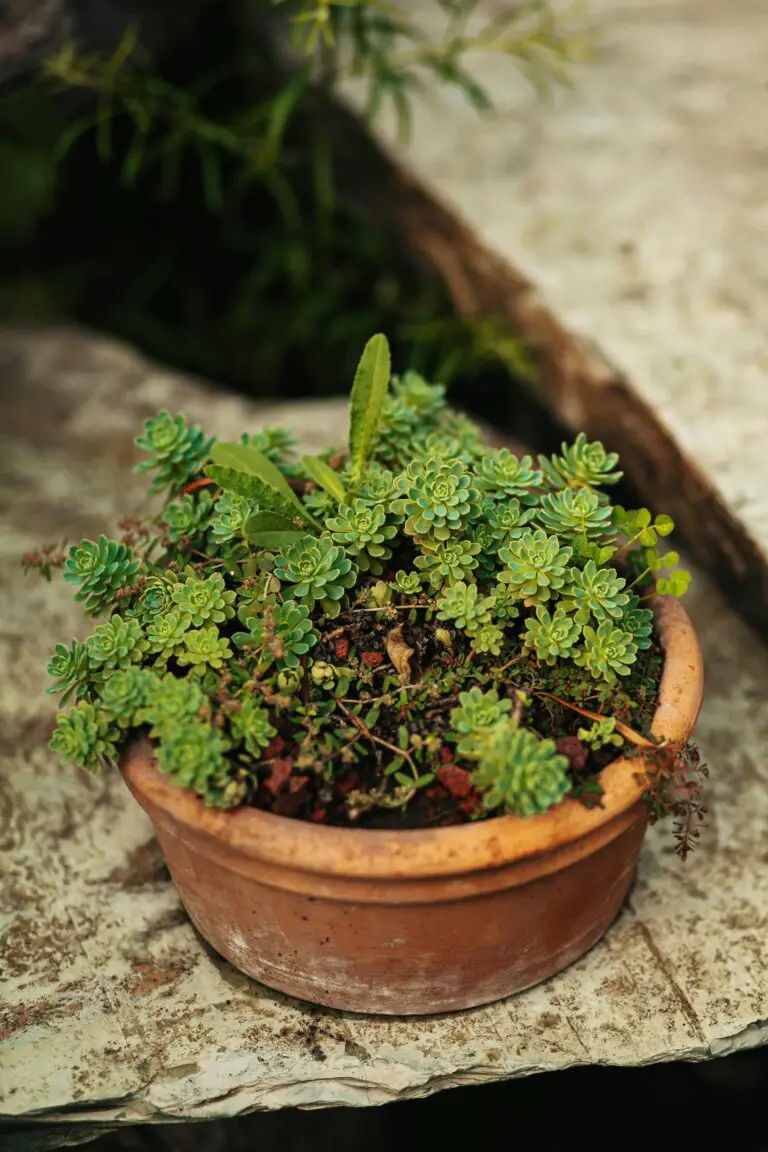Introduction to Sedum and Sandy Soils
Welcome to the secret world of sedum, a resilient fighter in the diverse terrain of the plant kingdom! Let’s take a dive into the sandy soils and see whether this plucky plant can call it home. Imagine, if you will, a stretch of dunes whispering under the kiss of a salty sea breeze, or the warm, grainy texture of a beach that gets everywhere – yes, even there. That’s the arena we’re exploring for our tenacious little friend, the sedum.
Sedum, a genus with star-studded versatility, boasts over 400 species often hailed as the superheroes of succulents. They bask under the sun like beachgoers lounging on the sandy shores, unfazed by the trials of drought or poor soil. It’s like they have their own superpower – the ability to thrive where fussier plants might throw in the trowel. Now, while sedum is not picky and can often handle ‘fast-draining soil’ being on its dating profile, does that extend to the sandy catwalks of your garden’s shoreline-inspired sections?
Well, sandy soil isn’t just any old substrate; it’s the charismatic rogue of the soil world. It’s got mineral moxie thanks to its predominantly quartz composition and loves to let water run through its fingers – or particles, to be precise. Draining faster than a sink with no plug, sandy soils keep roots from staying soaked and can be surprisingly fertile when they hang onto just enough nutrients.
As luck would have it, we have a trove of tips and tricks to ensure your sedum and other green companions live their best lives! But before we get ahead of ourselves, let’s focus on how our sandy soils and serendipitous sedum might just be the match made in horticultural heaven.
To give you a glimpse of the sedum’s splendor, feast your eyes on this beauty!

Now that you’ve seen the potential, let’s continue to scrutinize those sandy soils and see if we’re on the brink of declaring a flourishing friendship between them and the sedum. Stay tuned as we root around for the truth!
Sedum’s Soil Compatibility: Can it Handle the Beach-like Beds?
When it comes to sandy soils, many gardeners throw in the trowel, but not sedum! This resilient plant defies the odds and thrives in the loose, well-drained conditions that sandy terrain offers. Let’s dig into why sedum is a top contender for your sandy garden patches. Imagine these plump, water-storing leaves rooting firmly where many other plants simply couldn’t hold their ground.
Not all heroes wear capes; some come with succulent leaves. Sedum species, sometimes fondly referred to as ‘stonecrop,’ have an exceptional ability to establish in sandy soil, making them a top pick for coastal gardeners or anyone with sandy loam in their landscape. What makes sedum such a good fit? It’s all about their drought-tolerant nature, courtesy of thick, fleshy leaves that conserve water like a camel in miniature.
While most sedum varieties will accept sandy conditions with open arms, some stand out as true sand warriors. Sedum reflexum, also known as ‘blue spruce stonecrop,’ sports a unique blue-green hue and needle-like leaves that create a textural masterpiece in any sunny spot. Then there’s Sedum sexangulare, with its fast-spreading habit, ideal for creating a lush tapestry over your sandy soil.
Bearing the coastal winds and flaunting their colors doesn’t just come naturally; sedum plants have adapted to sandy soils over time. Their shallow root systems spread out to stabilize the ground while reaching for every speck of moisture, an extraordinary adaptation showcased by this  . So next time you’re making sandcastles, pay homage to these resilient beauties that thrive in similar grounds.
. So next time you’re making sandcastles, pay homage to these resilient beauties that thrive in similar grounds.
Interested in more than just the ground cover? Sedum ‘Autumn Joy’ commands attention with its broccoli-like blossoms, transitioning from green to a rich rosy hue as summer wanes to fall. This variety rises to the occasion even in the leanest of sandy soils, transitioning your garden through the seasons with an evolving color palette.
To maintain a thriving sedum oasis amidst the grains, it’s essential to understand their growing needs—a topic we cover in our guide on seasonal care for these rustic charmers. From proper watering routines to the ideal sun exposure, there’s a bit of finesse involved in nurturing these drought warriors to their full potential.
At the end of the day, whether you’re eyeing an audacious array of ‘Dragon’s Blood’ sedum with its fiery foliage, or the delicate ‘Cape Blanco’ with its powdery white leaves, sandy soil need not be a barren wasteland. With the right sedum companion, you can turn it into a flourishing display of tenacity and charm — no sandy pants required!
Advantages of Sandy Soils for Sedum
Imagine a landscape of lush, textured Sedum, their fleshy leaves basking in the sun, all rooted in the understated hero of horticulture: sandy soil. Our handy tips can guide you through the nuances of working with sandy terrain. But why is sandy soil such a boon for these sturdy succulents? Let’s dig a little deeper!
Sandy soil is like a breath of fresh air for plant roots, particularly for sedum. This soil type boasts excellent drainage, meaning water flows through easily without leaving behind sogginess or waterlogging. Think of it as the ideal bed for Sedum, allowing them to quench their thirst without the risk of root rot. In fact, too much moisture is a no-go for these drought-loving plants. With sandy soil, sedum is free to prosper without the “wet feet” that could spell disaster.
Improved Aeration: A Breath of Fresh Soil for Sedum
Beyond moisture management, sandy soil is also a star when it comes to aeration. The larger particle size means there’s more space for air to circulate freely around the roots. And what does that mean for your sedum? Robust growth and a vigorous root system! Each breath of soil (so to speak) encourages stronger, healthier plants that can stand up to various conditions, withstanding spells of drought and heat with ease.
Now, you might be pondering if sandy soil offers enough nutrients for Sedum to truly thrive. Here’s the scoop: While it’s true that sandy soils can be lower in nutrients, sedum doesn’t demand a feast of fertility. This hardy genus is adept at making the most of what’s available, its modest needs aligning perfectly with the characteristics of sandy soil.
Their adaptability even extends to seaside gardens where the soil is notoriously sandy. Sedum can perform quite the balancing act, coping with the high salt content and still putting on an impressive show of endurance and beauty. It’s no wonder sedum is often the go-to choice for creating a dynamic, resilient ground cover in diverse environments.
Let’s not forget practicality! Working with sandy soil is a gardener’s delight. It’s easier to till and work with, making planting a breeze. It warms up faster in spring, shaking off the chill of winter swiftly and giving your sedum an early start on the growing season. They’ll be sprouting and flourishing while other plants are still hitting the snooze button.
Is the evidence clear yet? Sandy soils are practically tailor-made for sedum’s success. So, whether you’re creating an alpine rockery, a xeriscape masterpiece, or just want to enjoy the simple pleasure of these succulents, sandy soil has got your back—or rather, your plants’ roots!
Challenges of Growing Sedum in Sandy Soil
For the green-thumbed enthusiast looking to diversify their garden with sedum, a question often arises: will sedum grow in sandy soil? Sandy soil, with its loose structure and quick drainage, may seem like formidable terrain for this hardy succulent. Let’s dig into the gritty details and explore the crux of the matter for gardeners.
Sedum, known for its drought tolerance and low maintenance disposition, actually prefers environments that echo its native rocky outcroppings. However, sandy soil poses a unique conundrum. Nutrient leaching is a key issue, as essential sustenance quickly percolates through the soil, leaving little behind for the plant. Imagine a swift-flowing river compared to a sluggish creek. In the same way, nutrients bypass the needy roots in speedy sand, unlike in denser soils where they linger long enough to be absorbed.
Furthermore, sandy soil leads to thirsty sedum plants. Even though sedum thrives in dry conditions, a balance is necessary. Without sufficient moisture retention, the roots might miss out on the hydration they need during crucial growth periods. It’s akin to providing a sponge with just a drop of water when what’s needed is a steady mist.
Real-life examples abound of gardeners taking on the sandy soil challenge. A visit to coastal or desert gardens, where sand is the mainstay, often showcases sedum varieties looking vibrant and robust, thanks to the introduction of organic matter which improves moisture retention, or the use of mulches that reduce moisture evaporation. These are testament to the fact that while sandy soil might present hurdles, they are not insurmountable for the determined gardener.
But don’t just take our word for it. Enjoy a visual expedition through these challenges and solutions with a helpful guide from gardening experts. Whether you’re a seasoned pro or a budding enthusiast, this insight can light the path to a flourishing sedum garden, even in the face of sandy adversity.
The takeaway here is not to be daunted by the immediate difficulties posed by sandy soil. With strategic planning and a few garden hacks, sedum can not only survive but thrive under such conditions. It’s a classic case of understanding your terrain and adapting your planting approach to emerge victorious on the other side of the botanical battle.
Sedum Soil Preparation: Sandy Edition
Sandy soil might feel like a curse to avid gardeners, with its quick-draining properties and sometimes lackluster nutrient profile. Yet, our plucky sedum plants are the Hercule Poirot of the gardening world – they thrive in such mysteries where others would falter! But why leave it all to chance? Let’s dig into some tips and techniques to give these resilient succulents the home they deserve. It’s all about setting the stage for success, so here’s how you can transform that sandy terrain into a sedum paradise.
First off, remember that sedum – those drought-tolerant champions – don’t necessarily need the rich, compost-heavy soils that other plants crave. In fact, throw too much organic matter at them and you might just see them turn up their noses (or roots, in this case). Instead, the goal is to strike a balance; we want to make that sandy soil hospitable without overdoing it. Picture this: you blend in some compost, perhaps some peat moss and a sprinkle of bone meal, creating an open-air buffet of just the right nutrients and water retention for your succulents.
But sandy soil isn’t all about the take; it’s a giver too! With its excellent drainage, you won’t find your sedum’s feet getting wet and unhappy with root rot. To capitalize on this, consider a raised bed or mound planting. This isn’t just about aesthetics; it’s for practicality, too. When sedum roots can spread out and truly embrace their sandy substrate, you’ll witness a sight to behold: robust growth, vibrant colors, and a resiliency that’s second to none.
Let’s not just talk; let’s see it in action! I’ve found this insightful video that not only entertains but educates on the art of preparing the perfect home for sedum in sandy environments:
No green thumb is complete without a touch of experimentation. What if you mixed in some gravel or coarse sand to your soil composition? Imagine the drainage! Your sedum could potentially grow as if it were on the slopes of a sun-kissed Mediterranean hillside. The key here is to provide enough structure for the roots, as this can prevent erosion and keep your plants anchored through winds and rain.
And let’s not forget water – that precious, fickle friend. While sedum is tolerant of neglect, that does not mean we should ignore it entirely. A soaker hose snaked through your sedum garden can provide just the right amount of moisture, especially during those dry spells, subtly delivering what your sandy soil might lack in water retention without encouraging the dreaded damp.
Ah, but we talk of sandy soil as if it’s all the same – a rookie mistake! The truth is, sand varies as much as sedum themselves. From the fine quartz sand of a beach to the heavier granules of inland areas, each type can affect how you prepare your soil and care for your sedum. Observation is key; watch how water flows and how quickly your soil dries out after rain. Finding that sweet spot of moisture – that’s where your sedum will serenade you with their growth.
Now, armed with knowledge and a sprinkle of creativity, picture yourself stepping out to survey your garden. There, amidst the grains of sandy soil, thrives a lush tapestry of sedum, brimming with life and color. It’s a testament to the potential hidden within seemingly challenging conditions, and a reminder that with the right preparation, any soil can become a stage for horticultural success.
Sedum Care and Maintenance in Sandy Situations
With the right approach, sedum, known for its hardy nature and succulent leaves, can not only grow but truly flourish in sandy soil. The key to success lies in understanding the unique requirements of this vibrant plant when faced with the fast-draining conditions typical of sandy terrain.
Watering needs for sedum are quite minimal, as these resilient plants are drought-tolerant. However, sandy soil can sometimes be too efficient at draining, leaving sedum roots thirsty. Frequent, lighter watering sessions will ensure that your sedums receive just the right amount of moisture without water logging, which they particularly dislike. Picture the sedum as the laid-back resident of your garden that prefers a sip over a gulp; a shallow yet consistent bit of water is more their style.

Fertilization is another aspect to consider. While sedum isn’t a heavy feeder, the leaching effect of sandy soil can quickly wash away nutrients. Utilizing a slow-release, balanced fertilizer in the early spring can give your plants the head start they need. Imagine giving your sedums a packed lunch for a long day – just enough to keep them thriving without the burden of excess.
Real-life examples of sedum thriving in sandy situations can be seen in coastal areas where gardeners often praise the plant for its ability to adapt. Homeowners on sandy bluffs who’ve added sedum to their landscape report a pleasing influx of color and texture, with minimal maintenance required. Just like a beachcomber finding treasures in the sand, your sedum will uncover what it needs to prosper in this unique environment.
Remember, sedum’s success in sandy soil mirrors life’s larger lessons: provide the right care and circumstances, and watch as resilience and beauty unfold. With thoughtful watering and the right nutrition, your sandy soil garden will be a testament to the adaptable nature of sedum.
Top Sedum Varieties for Sandy Soil Lovers
Are you a sandy soil enthusiast looking to sprinkle some green magic with plants that love a grainy embrace? Enter the world of sedums, the rugged beauties of the succulent family. These hardy plants laugh in the face of sandy soils, flourishing where others might only struggle to take root. Let’s dive into the specific sedum varieties that will joyfully make your sandy soil their home.

Sedum Spectabile ‘Autumn Joy’
Imagine the ‘Autumn Joy’ as it stands tall with its broccoli-shaped heads, flushing from soft pink to a burnished copper as summer fades to fall. The plant’s robust stems and fleshy leaves are perfect for sandy soil conditions, showcasing its drought-tolerant nature. Picture ‘Autumn Joy’ as the centerpiece of your sunny garden beds, attracting pollinators and awing onlookers with its fall color spectacle.
Sedum Reflexum ‘Blue Spruce’
Are you lacking pizzazz in certain areas of your sandy soil garden? ‘Blue Spruce’, with its needle-like leaves, might be the answer, creating the illusion of a miniature conifer forest in your very own backyard. This sedum variety thrives in fast-draining conditions, creating a sea of steel-blue that weaves flawlessly into rock gardens or along sandy pathways.
Sedum Acre ‘Golden Queen’
Don’t underestimate the ‘Golden Queen’, a sedum that carpets the ground in sandy soils with its golden-yellow blossoms. In the high noon of summer, this low-grower beams up at the sun, making the most of light conditions that would send other plants into wilt. Its vigorous growth habit ensures that even in the poorest of soils, it can spread its royal charm with ease.
Sedum Spurium ‘Dragon’s Blood’
A sedum that writes its own fantasy tale is ‘Dragon’s Blood’. This sedum variety paints a dramatic stroke across sandy terrains with its red-tinged foliage and blood-red summer flowers. It’s almost as if each leaf and bloom is a testament to the plant’s fire-breathing namesake, creating a mythical aura in your very real garden scenario.
The story of sedums in sandy soils is one of triumph. These varieties don’t just survive; they thrive, setting roots deep into loose soils and rising to greet the sun with colors and textures galore. By choosing one of these sandy soil-loving sedums, you’re not just planting a garden; you’re curating a natural work of art that can weather the elements with grace and vigor.
Real Gardeners’ Stories: Sedum Success in Sandy Settings
Anyone peering into the world of hardy plants that can withstand tough soil conditions has likely heard of sedum. Known for its resilience, this succulent has become a beacon of hope for gardeners dealing with less-than-ideal earth underfoot. The question on many minds, “Will sedum grow in sandy soil?” prompts us to dive into the personal experiences of those who have tried and succeeded in turning sandy terrains into sedum havens.
Take Sarah, for instance, a gardening enthusiast from the windswept coasts of Maine. Her sandy soil garden was her biggest challenge until she introduced sedum. Much to her delight, and contradicting her initial skepticism, the sedum not only survived but flourished, its roots gripping firmly in the loose granules. Emboldened by the plant’s display of tenacity, Sarah has converted a once barren patch into a lush sedum spectacle that draws neighbors’ admiration.
Then there’s Miguel, who resides in the parched climates of Arizona where sandy soil is more rule than exception. He shares a tale of transformation, where his passion for gardening was almost crushed by the unyielding soil composition. Sedum, with its spectacular adaptive qualities, became Miguel’s ally in the desert. Not only did the plants preserve moisture and reduce erosion, but they also provided a beautiful, verdant ground cover that defied the harsh desert sun.
Gardening Success with Sedum
In regions where rich loam is a dream, and sand rules the land, sedum emerges as a hero. The adaptability of this succulent genre sings songs of greenery even in the most inhospitable soils. Its drought resistance and ability to root in shallow, unforgiving terroir make it the go-to plant for many who once thought a verdant garden was an unreachable goal.
Gardeners like Sarah and Miguel aren’t anomalies. Their stories echo across the globe, from the sandy dunes of coastal regions to the gritty garden beds of urban dwellers. Sedum’s success isn’t a mere stroke of luck; it’s a testament to the plant’s impressive versatility and the determination of those who tend it.
Dive into the specifics of how sedum thrives in these conditions with the following video, which sheds light on the care and propagation of Sedum Clavatum. Watch and learn how to replicate these successful gardeners’ green thumb exploits:
As these real gardeners’ stories illustrate, with a little research, the right approach, and a dash of optimism, growing sedum in sandy soil isn’t just possible—it’s a gateway to a thriving garden that celebrates the beauty and resilience of nature against all odds.
Frequently Asked Questions
Are you pondering whether those gritty dunes could become a lush haven for the resilient sedum? Well, you’re not alone! Many green thumbs like you wonder if sedum plants can defy the odds and flourish in sandy soil. Let’s dig into the world of sedum and uncover the nitty-gritty of cultivating it in sandy terrain.
Does Sandy Soil Suit Sedum?
Imagine a botanical survivor, one that thrives where others barely survive. That’s sedum for you! These hardy succulents are not just about pretty faces; they’re about resilience, drought tolerance, and adaptability. Whether it’s atop a gritty outcrop or within porous, well-drained backyard sands, sedum plants punch above their weight, turning less-than-ideal conditions into a botanical showcase!
Think of it like this: just as a camel marches unfazed through arid deserts, sedum plants stand tall in sandy soils. This adaptability makes them a favorite among gardeners facing sandy challenges. With enduring spirit, they don’t just grow; they often thrive. And here’s a fun fact–sedum’s succulent leaves are like mini reservoirs, storing water for the not-so-rainy days, ensuring survival in soils that keep lesser plants thirsting for moisture.
Are There Any Sedum Varieties Better Suited for Sandy Soils?
Walk into the world of sedum, and you’ll find a smorgasbord of species with a unified love for loose, grainy foundations. From the creeping Sedum acre to the upright Sedum spectabile, there’s a variety that not only tolerates but revels in sandy soils. The secret lies in their thick, fleshy leaves and stout, water-storing stems. Some might say they have a “sand-loving” superpower embedded in their DNA.
Now, let’s take a peek at a visual guide packed with actionable insights for your sedum journey. This engaging video will show you just how versatile these plants can be, even in sandy soils:
In summary, sedum plants are not only capable of growing in sandy soil; they embrace it with open arms. Their innate ability to conserve water and withstand drought makes them a go-to choice for sandy terrains. Gardeners looking to transform these soils into a spectacular sedum showcase have a myriad of varieties to choose from. Each one equipped to turn the impossible into the incredible!



